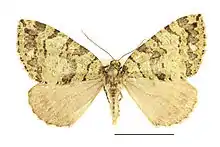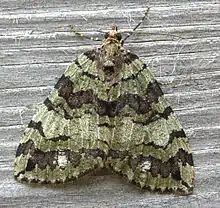Hydriomena furcata
Hydriomena furcata, the July highflyer, is a moth of the family Geometridae. The species was first described by Carl Peter Thunberg in 1784. It is found in the Holarctic ecozone.

| Hydriomena furcata | |
|---|---|
 | |
 | |
| Scientific classification | |
| Kingdom: | Animalia |
| Phylum: | Arthropoda |
| Class: | Insecta |
| Order: | Lepidoptera |
| Family: | Geometridae |
| Genus: | Hydriomena |
| Species: | H. furcata |
| Binomial name | |
| Hydriomena furcata (Thunberg, 1784) | |
| Synonyms | |
| |
Description
The wingspan is 23–30 mm. The ground colour ranges from green through to brown. The dark cross bands vary in intensity and pattern. There is anapical streak on the forewings. The hindwings are pale brown. It "differs from the other European species of Hydriomena in the shorter palpus, the more angled or irregular markings between the subbasal line and the median space, dark subterminal band, nearly always interrupted by a white or pale spot in the middle, absence of black vein-streaks near the apex".[1]
Distribution
It is found in Europe, the Caucasus, Transcaucasia, Urals, Kazakhstan, Siberia, Russian Far East, northern Mongolia, China, Korea, In North America, from Alaska to British Columbia and Newfoundland. It is extremely abundant in northern Europe; in central Europe it becomes more local and in the south it is apparently almost lacking; in Siberia and central Asia it has a wide range.
Adults are on wing from May to August. There is one generation per year.
The larvae feed on various broad-leaved trees and shrubs, including Salix and Vaccinium myrtillus.
Subspecies
- Hydriomena furcata furcata
- Hydriomena furcata fergusoni
References
- Prout, L. B. 1912–16. Geometridae. In A. Seitz (ed.) The Macrolepidoptera of the World. The Palaearctic Geometridae, 4. 479 pp. Alfred Kernen, Stuttgart.
